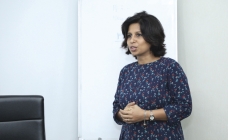‘We independently verify campaign facts, at scale’
By Rajiv Raghunath - April 13, 2021
Joe Copley, Chief Revenue Officer, Seedooh points out that CEOs and CMOs the world over are seeking a better understanding of ROI - and that starts with rich, connected, available, accurate data
 Seedooh has pioneered a highly reliable OOH campaign reporting system through its Independent Verification Platform (IVP). What factors have contributed to a wider market acceptance of your 3rd party verification and reporting solutions?
Seedooh has pioneered a highly reliable OOH campaign reporting system through its Independent Verification Platform (IVP). What factors have contributed to a wider market acceptance of your 3rd party verification and reporting solutions?
Firstly, recognition amongst sector participants that the future of OOH requires standards, standardisation and connectivity that have already been achieved by other digitised media sectors, as they have matured. DOOH publishers in Australia and New Zealand have been progressive in this regard, relative to other markets - but there has also been significant encouragement from the buy-side, where agencies are increasingly feeling responsible for stewardship of their clients’ media budgets. This is a global trend, starting at the source of the money - the advertisers - who are seeking more transparency and asking more questions, about exactly how their budgets are being invested. CEOs and CMOs the world over are seeking a better understanding of ROI - and that starts with rich, connected, available, accurate data.
Secondly, Seedooh enables this progression at market scale, without adding any additional steps in the campaign delivery process, for media owners, agencies or advertisers. In fact, automated reporting and verification via the Seedooh Platform generates up to 90% time and resource efficiencies for all participants.
Is your ’Truth Technology’ offering largely applied in the DOOH space, or is there scope for generating similar proof of performance reports on classic media campaign rollouts?
Seedooh is format agnostic -- we independently apply best-practice verification controls to any public space media where there is verifiable system data. By ‘best-practice verification controls’, we mean compliant with SOC 2 - the leading global assurance standard in non-financial data controls. In Australia, we are verifying campaigns in DOOH, Classic OOH, StreetPosters, Sporting Stadia and big-screen, pre-movie Cinema advertising. For campaigns which use multiple channels and formats, the data and analysis is available via a single secure, standardised platform in almost real time.
Do you see OOH business growth for media operators in markets where independent campaign verification services are subscribed to in larger numbers?
Yes, on two levels: Firstly, the confidence provided by genuine, best-practice third party verification at scale, at a nominal cost to the advertiser, is a critical hygiene factor that will serve OOH well as it matures into the connected, omnichannel future. Secondly, the efficiencies resulting from fully automated and verified campaign reporting mean that both sellers and buyers can focus more time and effort on creating better campaign solutions, which will ultimately lead to greater recognition of the valuable role that OOH can play in communications and hence more growth in demand.
Which are the markets where Seedooh has maximum business footprints? Do you think that emerging markets like India would be attractive business destinations for Seedooh?
Seedooh was launched in Australia in July 2017 and we’re now verifying 90% of DOOH activity, around 30% of Classic OOH, approximately 40% of all cinema advertising, plus the main signage displays at sporting stadiums for AFL and Cricket matches.
In what started as our sector wide proof of concept market, we are very pleased with this progress. Along the way, we have evolved every aspect of the platform to incorporate every relevant variable in each sub-sector - variables which are similar in all markets. The UI has benefitted over 3 years through feedback from almost 3,000 registered users. And all this, whilst still maintaining the integrity of standards and controls in line with global best-practice in assurance - for every one of around 50bn data points - and improving efficiency by automating all this reporting at market scale. We’re on track to achieve a similar footprint in New Zealand during 2021 and have already completed integrations and POCs in Europe and Japan, which have since been paused during the pandemic.
As markets in Asia, including India, continue to evolve and mature, they will become very interesting for us. The Seedooh technology is proven at scale and can be deployed remotely, wherever appropriately structured workflow systems are used to manage the delivery of campaigns to public space media networks. It sometimes takes a little time for businesses to appreciate the value in automated reporting - and to embrace the idea of complete transparency and accountability in campaign delivery.
Sometimes the demand in a new market comes from brands and agencies, sometimes there is a confident media owner who sees the advantage of taking a lead position. We are consulting with a number of businesses who are exploring this future in Europe, the US, Africa, The Middle East and SouthEast Asia - but we don’t have any live discussions happening in India at this stage.
You also provide campaign analysis to client organisations. What kind of insights and analytics do you provide?
Great question. Agencies and media owners generally self-serve the data from the Seedooh Platform - it’s highly intuitive and the data can be easily analysed to individual play level if required, with a few clicks. Every campaign is different and these users know exactly what they are looking for, starting with a summary overview and digging into specifics.
For advertisers, or less frequent agency users, we provide an insights and analytics service, to help them understand more clearly the particular aspects of the campaign that they are interested in -- if they are using multiple creative, dynamic or programmatic delivery, or if they want to understand the complexities that site-specific variables, such as loop policies have on the exposure time on screen, for example.
Any variable of campaign delivery in the real world can be understood better using Seedooh data, so the analytics are dependent on the campaign parameters. Ultimately, we are verifying what was intended to happen, versus what actually happened. Usually the two data sets are different, often as a result of over-delivery, sometimes other anomalies. It always helps to be able to easily quantify and explain where there was extra value, or where things have not gone according to plan. In the case of the latter, it’s better for everybody when the irregularities are identified early, in almost real-time - and can be rectified quickly.

Stay on top of OOH media trends








